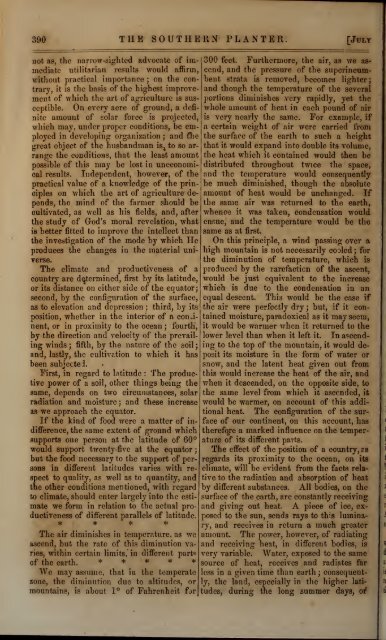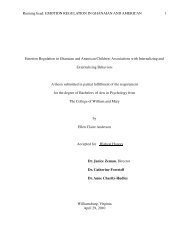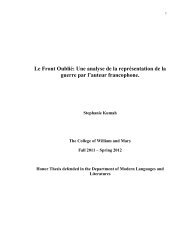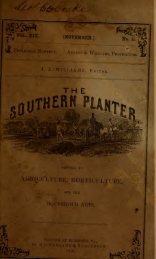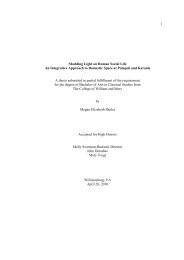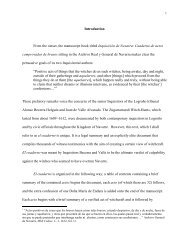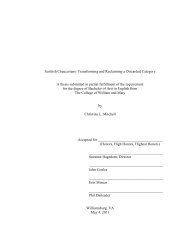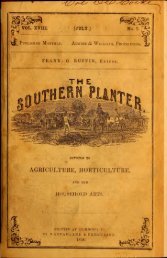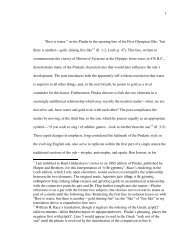Southern planter - The W&M Digital Archive
Southern planter - The W&M Digital Archive
Southern planter - The W&M Digital Archive
You also want an ePaper? Increase the reach of your titles
YUMPU automatically turns print PDFs into web optimized ePapers that Google loves.
390 THE SOUTHERN PLANTER. [July<br />
not as, the narrow-sighted advocate of immediate<br />
utilitarian results would affirm,<br />
without practical importance ; on the contrary,<br />
it is the basis of the highest improvement<br />
of which the art of agriculture is sus-<br />
ceptible. On every acre of ground, a defi-<br />
nite amount of solar force is projected,<br />
which may, under proper conditions, be employed<br />
in developing organization ; and €he<br />
great object of the husbandman is,to so arrange<br />
the conditions, that the least amount<br />
possible of this may be lost in uneconomical<br />
results. Independent, however, of the<br />
practical value of a knowledge of the prin-<br />
ciples on which the art of agriculture depends,<br />
the mind of the farmer should be<br />
cultivated, as well as his fields, and, after<br />
the study of God's moral revelation, what<br />
is better fitted to improve the intellect than<br />
the investigation of the mode by which He<br />
produces the changes in the material uni-<br />
verse.<br />
<strong>The</strong> climate and productiveness of a<br />
country are determined, first by its latitude,<br />
or its distance on either side of the equator;<br />
second, by the configuration of the surface,<br />
as to elevation and depression ; third, by its<br />
position, whether in the interior of a conti-<br />
nent, or in proximity to the ocean ; fourth,<br />
by the direction and velocity of the prevailing<br />
winds; fifth, by the nature of the soil;<br />
and, lastly, the cultivation to which it has<br />
been subjected.<br />
First, in regard to latitude : <strong>The</strong> produc-<br />
tive power of a soil, other things being the<br />
same, depends on two circumstances, solar<br />
radiation and moisture; and these increase<br />
as we approach the equator.<br />
If the kind of food were a matter of indifference,<br />
the same extent of ground which<br />
supports one person at the latitude of 60°<br />
would support twenty-five at the equator<br />
but the food necessary to the support of per-<br />
sons in different latitudes varies with respect<br />
to quality, as well as to quantity, and<br />
the other conditions mentioned, with regard<br />
to climate, should enter largely into the estimate<br />
we form in relation to the actual productiveness<br />
of different parallels of latitude.<br />
* * * *<br />
*****<br />
<strong>The</strong> air diminishes in temperature, as we<br />
ascend, but the rate of this diminution va-<br />
ries, within certain limits, in different part*<br />
300 feet. Furthermore, the air, as we ascend,<br />
and the pressure of the superincumbent<br />
strata is removed, becomes lighter;<br />
and though the temperature of the several<br />
portions diminishes very rapidly, yet the<br />
whole amount of heat in each pound of air<br />
is very nearly the same. For example, if<br />
a certain weight of air were carried from<br />
the surface of the earth to such a height<br />
that it would expand into double its volume,<br />
the heat which it contained would then be<br />
distributed throughout twice the space,<br />
and the temperature would consequently<br />
he much diminished, though the absolute<br />
amount of heat would be unchanged. If<br />
the same air was returned to the earth,<br />
whence it was taken, condensation would<br />
ensue, and the temperature would be the<br />
same as at first.<br />
On this principle, a wind passing over a<br />
high mountain is not necessarily cooled; for<br />
the diminution of temperature, which is<br />
produced by the rarefaction of the ascent,<br />
would be just equivalent to the increase<br />
which is due to the condensation in an<br />
equal descent. This would be the case if<br />
the air were perfectly dry ; but, if it contained<br />
moisture, paradoxical as it may seem,<br />
it would be warmer when it returned to the<br />
lower level than when it left it. In ascending<br />
to the top of the mountain, it would de-<br />
posit its moisture in the form of water or<br />
snow, and the latent heat given out from<br />
this would increase the heat of the air, and<br />
when it descended, on the opposite side, to<br />
the same level from which it ascended, it<br />
would be warmer, on account of this addi-<br />
tional heat. <strong>The</strong> configuration of the surface<br />
of our continent, on this account, has<br />
therefore a marked influence on the temper-<br />
ature of its different parts.<br />
<strong>The</strong> effect of the position of a country, as<br />
regards its proximity to the ocean, on its<br />
climate, will be evident from the facts rela-<br />
tive to the radiation and absorption of heat<br />
by different substances. All bodies, on the<br />
surface of the earth, are constantly receiving<br />
and giving out heat. A piece of ice, exposed<br />
to the sun, sends rays to this lumina-<br />
ry, and receives in return a much greater<br />
amount. <strong>The</strong> power, however, of radiating<br />
and receiving heat, in different bodies, is<br />
very variable. Water, exposed to the same<br />
of the earth.<br />
We may assume, that in the temperate<br />
source of heat, receives and radiates far<br />
less in a given time than earth ; consequent-<br />
zone, the diminution due to altitudes, or ly, the land, especially in the higher lati-<br />
mountains, is about 1° of Fahrenheit for tudes, during the long summer days, or<br />
_


